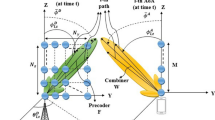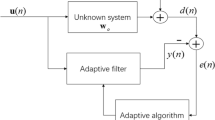Abstract
Movements of the scattering center on the condition of ultra-wideband (UWB) will impact the extraction of parameters. This paper presents an approach for extracting the moving targets’ UWB scattering center parameters based on the geometrical theory of diffraction (GTD) model and the state space approach. Firstly, the UWB GTD scattering model is transformed into state-space equations in order to estimate the range and range rate through the singular value decomposition. Secondly, the type parameter in the whole bandwidth is indicated dimension-reducedly by orthonormalized basis and estimated by traversal algorithm and minimumnorm algorithm. Finally, the intensity of scattering center is worked out based on the least square method. The paper provides the Cramer-Rao bound (CRB) for parameter estimation. The effectiveness of the approach is verified by computer simulation. The approach can estimate range, range rate, reflection intensity and type parameter simultaneously in order to improve the track of scattering centers and the target identification.
Similar content being viewed by others
References
Keller J B. Geometrical theory of diffraction. J Opt Soc Amer, 1962, 52: 116–130
Hurst M, Mittra R. Scattering center analysis via Prony’s method. IEEE Trans Antenn Propag, 1987, 35: 986–988
Wang J, Wang F, Zhou J. Radar target scattering center extraction based on the full-polarization GTD model. Int Joint Confer Comput Sci Opt, 2009, 1: 882–885
Steedly W M, Moses R L. High resolution exponential modeling of fully polarized radar returns. IEEE Trans Aero Electr Syst, 1991, 27: 459–469
Carriere R, Moses R L. High resolution radar target modeling using a modified Prony estimator. IEEE Trans Antenn Propag, 1992, 40: 13–18
Fuller D F, Terzuoli A J, Collins P J, et al. 1-D feature extraction using a dispersive scattering center parametric model. IEEE Antenn Propag Socie Interna Sympos, 1998, 2: 1296–1299
Moghaddar A, Ogawa Y, Walton E K. Estimating the time-delay and frequency decay parameter of scattering components using a modified MUSIC algorithm. IEEE Trans Antenn Propag, 1994, 42: 1412–1418
Potter L C, Chiang D M, Carriere R, et al. A GTD-based parametric model for radar scattering. IEEE Trans Antenn Propag, 1995, 43: 1058–1067
Van Blaricum M, Mittra R. A technique for extracting the poles and residues of a system directly from its transient response. IEEE Trans Antenn Propag, 1975, 23: 777–781
Mackay A J, McCowen A. An improved pencil-of-functions method and comparisons with traditional methods of pole extraction. IEEE Trans Antenn Propag, 1987, 35: 435–441
Hua Y, Sarkar T K. Generalized pencil-of-functions method for extracting poles of an EM system from its transient response. IEEE Trans Antenn Propag, 1989, 37: 229–234
Hua Y, Sarkar T K. Matrix pencil method for estimating parameters of exponentially damped/undamped sinusoids in noise. IEEE Trans Acoust Speech Sig Process, 1990, 38: 814–824
McClure M, Qiu R C, Carin L. On the superresolution identification of observables from swept-frequency scattering data. IEEE Trans Antenn Propag, 1997, 45: 631–641
Burrows M L. Two-dimensional ESPRIT with tracking for radar imaging and feature extraction. IEEE Trans Antenn Propag, 2004, 52: 524–532
Yang J, Sarkar T K. Interpolation/extrapolation of radar cross section (RCS) data in the frequency domain using the Cauchy method. IEEE Trans Antenn Propag, 2007, 55: 2844–2851
Bi Z, Li J, Liu Z S. Super resolution SAR imaging via parametric spectral estimation methods. IEEE Trans Aero Electr Syst, 1999, 35: 267–281
Kung S Y, Arun K S, Rao D V. State-space and singular-value decomposition-based approximation methods for the harmonic retrieval problem. J Opt Soc Am, 1983, 73: 1799–1811
Naishadham K, Piou J E. A robust state space model for the characterization of extended returns in radar target signatures. IEEE Trans Antenn Propag, 2008, 56: 1742–1751
Piou J E. A state identification method for 1-D measurements with gaps. In: AIAA Guidance Navigation and Control Conf, San Francisco, CA, 2005
Naishadham K, Piou J E. State-space spectral estimation of characteristic electromagnetic responses in wideband data. IEEE Antenn Wirel Propag Lett, 2005, 4: 406–409
Piou J E, Cuomo K M, Mayhan J T. A state-space technique for ultrawide-bandwidth coherent processing. Tech. Rep. 1054, MIT Lincoln Laboratory, Jul. 1999
Rao B D, Arun K S. Model based processing of signals: a state space approach. IEEE Proc, 1992, 80: 283–309
David J H. State-space approaches to ultra-wideband Doppler processing. PhD thesis, Worcester Polytechnic Institute, 2007. 33–37
Akaike H. A new look at the statistical model identification. IEEE Trans Autom Control, 1974, 19: 716–723
Wax M, Kailath T. Detection of signals by information theoretic criteria. IEEE Trans Acoust Speech Sig Process, 1985, 33: 387–392
Rissanen J. Modeling by shortest data description. Automatica, 1978, 14: 465–471
Wax M, Ziskind I. Detection of the number of coherent signals by the MDL principle. IEEE Trans Acoust Speech Sig Process, 1989, 37: 1190–1196
Van Trees H L. Optimum Array Processing, Part IV of Detection, Estimation, and Modulation Theory. New York: John Wiley & Sons, Inc., 2002. 925–928
Koets M A, Moses R L. Feature extraction using attributed scattering center models on SAR imagery. In: SPIE 3721, Orlando, FL, 1999
Shi Z G, Zhou J X, Zhao H Z, et al. Study on joint Bayesian model selection and parameter estimation method of GTD model. Sci China Ser F-Inf Sci, 2007, 50: 261–272
Author information
Authors and Affiliations
Corresponding author
Rights and permissions
About this article
Cite this article
Wang, J., Wei, S., Sun, J. et al. A GTD model and state space approach based method for extracting the UWB scattering center of moving target. Sci. China Inf. Sci. 54, 182–196 (2011). https://doi.org/10.1007/s11432-010-4137-z
Received:
Accepted:
Published:
Issue Date:
DOI: https://doi.org/10.1007/s11432-010-4137-z




